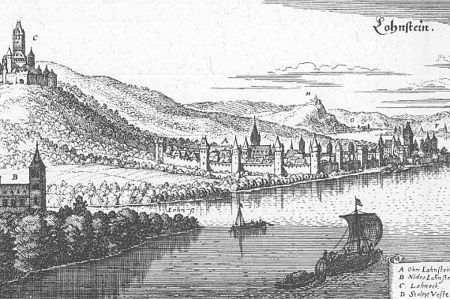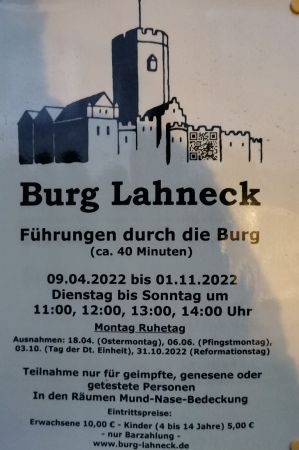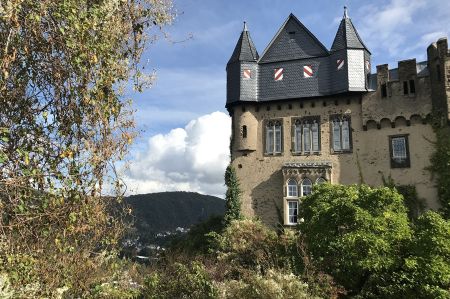Lahnstein and Lahneck Castle – A short overnight visit
- Written by Portal Editor
Appointments in Koblenz and near Frankfurt brought us to Lahnstein for the overnight stay, high above the Rhine and the Lahn, which we were to admire the next morning with a view of the moving clouds over the Rhine.
Since there was still some time available until the evening, a short walk to the Lahneck Castle should take place, also in search of a quiet place for dinner. So we first walked to the fortress and castle of Lahneck, then down to the town on the Lahn.
Roman fortresses and Lahneck Castle

The Lohenstein house, built on the remains of the Burgus, fell to Electoral Trier in 1018, and the late Romanesque St. John's Church was built on the same site in the 12th century.
With the start of construction of Lahneck Castle around 1226 by the Mainz Elector and Archbishop Siegfried II von Eppstein, the construction of the 29 m high pentagonal keep began, a special feature of fortress construction with a pentagonal floor plan similar to Stolzenfels Castle.

In contrast to many Rhine castles, Lahneck Castle was not used as a customs castle because it was too far from the Rhine. This task fell to Martinsburg Castle, which was located directly on the Rhine. The Gothic castle chapel was dedicated to Saint Ulrich. A papal deed from 1332 granted visitors to the chapel a forty-day waiver of church penalties (selling indulgences).
During the Palatinate War of Succession in 1688, Lahneck Castle was destroyed by French troops by setting the roofs on fire.
Idilia Dubb starves to death on the keep
By the way: This is where the Rheinhöhenweg, Lahnhöhenweg, Jakobsweg (Lahn-Camino from Wetzlar to Oberlahnstein and on to Kaub) and Rheinsteig hiking trails from Wiesbaden to Bonn cross.
On the history of Lahnstein on the Rhine and Lahn
So first a little tour of the town, where we noticed the old town hall of Oberlahnstein, which was first mentioned in 1507.
In 1569 a ferry line was built across the Lahn between Oberlahnstein and Niederlahnstein.
During the Thirty Years' War, both parts of the city were repeatedly occupied by Swedish, Imperial, French and Hessian troops.
After losing the German War on Austria's side in 1866, the Duchy of Nassau was annexed by Prussia. Lahnstein, now Prussian, began work on connecting its railway to the Prussian right-hand Rhine line by 1869. Since 1873, a road bridge over the Lahn has connected today's districts of Ober- and Niederlahnstein.
Dense clouds cover Rhine river
Please read as well:
First snow and pre-Christmas mood at Naumburg Cathedral
A detour with consequences - Passage of the Lake Dojran
-
-
-
-
-
-
-
-
-
https://www.alaturka.info/en/germany/rhineland-palatinate/5889-lahnstein-and-lahneck-castle-a-short-overnight-visit/amp#sigProId5025a70697
